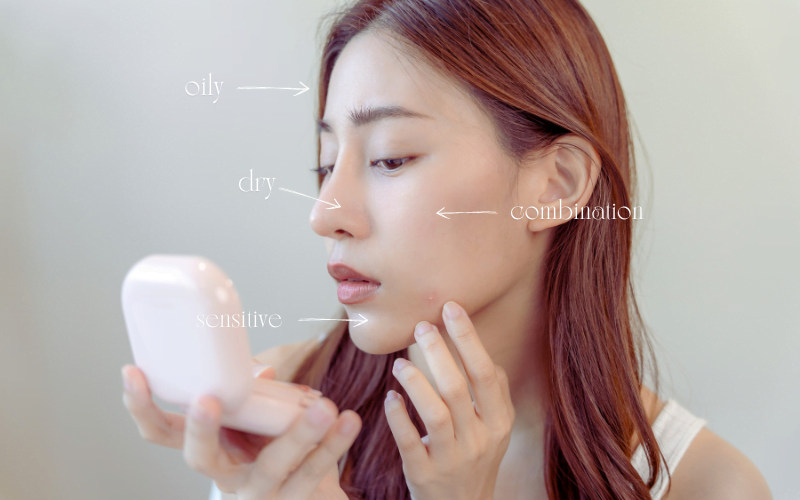
How to Build a Skincare Routine for Different Skin Types: Tailoring Your Routine for Oily, Dry, Combination, and Sensitive Skin

Identifying Your Skin Type
Understanding your skin type is the cornerstone of any effective skincare routine. There are four primary skin types: oily, dry, combination, and sensitive. Each skin type has distinct characteristics and signs that help in identification, ensuring your skincare regimen caters precisely to your needs.
Oily Skin
Oily skin is characterized by an overproduction of sebum, the skin’s natural oil. Individuals with oily skin often experience shine, particularly in the T-zone (forehead, nose, and chin). Signs include enlarged pores, frequent breakouts, and a greasy appearance. To self-assess, cleanse your face and observe if it becomes shiny just hours later. Genetic predisposition and hormonal changes often play significant roles in causing oily skin.
Dry Skin
Dry skin lacks sufficient moisture and oil, leading to a rough, flaky texture. Common signs include tightness, especially after washing, redness, and visible lines or cracks. Post-cleansing, dry skin feels parched and sometimes itchy. Environmental factors like cold weather and inadequate hydration can exacerbate dryness, while genetic factors are also influential.
Combination Skin
Combination skin is a blend of oily and dry skin types. Typically, the T-zone is oily, while the cheeks remain dry or normal. This variation makes it challenging to pick a one-size-fits-all routine. Look for uneven skin characteristics, such as shine in some areas and flakiness in others, to identify combination skin. This type often requires a balanced approach to cater to the different needs of various facial regions.
Sensitive Skin
Sensitive skin is prone to inflammation and adverse reactions to various products and environmental factors. Signs include redness, burning, itching, and frequent blotchiness. After cleansing, sensitive skin might feel irritated or exhibit visible signs of distress. Sensitivity can be influenced by genetics, irritants, and stress, necessitating the use of gentle, soothing products.
Factors such as genetics, environment, and lifestyle play significant roles in influencing your skin type. By examining how your skin reacts in different conditions and adhering to the self-assessment tips, you can accurately determine your skin type and tailor your skincare routine accordingly.
Building a Routine for Oily Skin
When constructing an effective skincare regimen for oily skin, the first step is selecting a gentle cleanser. This is crucial as it helps to manage excess oil without stripping the skin of its natural moisture. Opt for a cleanser with ingredients such as salicylic acid or benzoyl peroxide, known for their ability to control sebum production and keep pores clear of impurities.
After cleansing, incorporating a toner into your routine can further aid in oil control. Toners with salicylic acid or witch hazel are particularly beneficial for oily skin, as they help to reduce sebum production and tighten pores. This extra step in your routine can leave your skin feeling refreshed and balanced, rather than greasy.
Choosing the right moisturizer is equally important for oily skin. A lightweight, non-comedogenic moisturizer will provide hydration without clogging pores. Moisturizers labeled as oil-free or gel-based are ideal choices, as they are less likely to contribute to unwanted shine. Look for ingredients like hyaluronic acid, which offers hydration without adding extra oil to the skin.
For a deeper treatment, consider incorporating masks that contain clay or charcoal into your routine. These ingredients are excellent for absorbing excess oil and can help to purify the skin by drawing out impurities from the pores. Using such masks once or twice a week can significantly reduce shine and prevent breakouts.
An often-overlooked component of skincare for oily skin is the use of sunscreen. It is imperative to use a daily sunscreen that is specifically formulated for oily skin. Look for sunscreens that are non-comedogenic, oil-free, and have a matte finish to prevent pore clogging and additional shine.
By carefully selecting each product, from cleansers to toners, moisturizers, masks, and sunscreens, you can create a comprehensive and effective skincare routine tailored specifically for oily skin. This approach not only addresses the needs of oily skin but also supports overall skin health.
Creating a Routine for Dry Skin
Developing an effective skincare routine for dry skin involves a delicate balance of hydration and moisture retention. Begin your regimen with a gentle, hydrating cleanser that won’t strip the skin of its natural oils. Opt for products that contain soothing ingredients like aloe vera or chamomile, as they help maintain the skin’s moisture barrier without causing irritation.
Following cleansing, introduce an alcohol-free toner or essence into your routine. These products provide an additional layer of hydration, prepping the skin to better absorb subsequent treatments. Look for toners with hydrating agents such as rose water or glycerin, which can boost moisture levels without drying out the skin.
Next, apply a hydrating serum. Serums containing hyaluronic acid and glycerin are particularly beneficial for dry skin as they draw moisture into the skin, plumping and softening it. A concentrated dose of hydration will help alleviate the tightness and flakiness often associated with dry skin.
Emollient moisturizers are essential for locking in the hydration provided by serums and essences. Choose a rich moisturizer infused with nourishing ingredients like shea butter, ceramides, or fatty acids, which are known for their ability to strengthen the skin barrier and prevent moisture loss.
Incorporating regular exfoliation into your routine is also crucial. Dead skin cells can build up on the surface, making dry patches appear more prominent. Gentle exfoliation, using products with lactic acid or glycolic acid, can remove these dead cells and improve skin texture, allowing moisturizers to penetrate more effectively.
Finally, always apply a broad-spectrum sunscreen daily. Sun exposure can exacerbate dry skin, leading to further dehydration and sensitivity. A broad-spectrum SPF of at least 30 will protect the skin from harmful UVA and UVB rays, preventing damage and maintaining the integrity of your skincare routine.
Tailoring Your Routine for Combination and Sensitive Skin
Combination skin often presents a unique challenge, as it simultaneously exhibits characteristics of both oily and dry skin. A balanced approach is essential in managing this skin type effectively. Consider using different products specifically tailored to each zone. For the oily sections, lightweight, non-comedogenic moisturizers can help control excess oil production without clogging pores. Conversely, the drier areas benefit from richer, more hydrating creams to replenish and maintain moisture levels.
Gentle exfoliation is another key strategy in caring for combination skin. Incorporating a mild exfoliator, such as one with alpha hydroxy acids (AHAs), can help remove dead skin cells and prevent clogged pores without causing irritation. Exfoliation should be performed sparingly, ideally once or twice a week, to avoid over-exfoliating sensitive or dry areas.
Sensitive skin requires a tailored routine that prioritizes hypoallergenic and fragrance-free products. Opt for gentle cleansers that remove impurities without stripping away essential natural oils. Ingredients like chamomile and aloe vera in toners can soothe and calm the skin, reducing redness and irritation. When selecting moisturizers, look for options with minimal ingredient lists to minimize the potential for adverse reactions.
Patch testing new products is a crucial step for those with sensitive skin. Apply a small amount of the product to a discreet area of skin and wait 24-48 hours to check for any signs of irritation before incorporating it fully into your routine. This precaution can help prevent unnecessary flare-ups and maintain skin health.
Moreover, using mineral sunscreen is highly recommended for sensitive skin. These sunscreens typically contain zinc oxide or titanium dioxide, which are less likely to cause irritation compared to chemical sunscreens. Consistent use of mineral sunscreen protects the skin from harmful UV rays while minimizing the risk of adverse reactions.
By adopting these strategies, individuals with combination and sensitive skin can achieve a balanced and healthy complexion, accommodating the unique needs of different zones and minimizing irritation.



